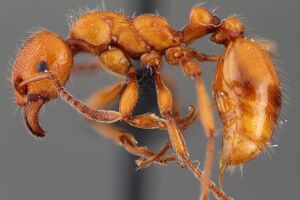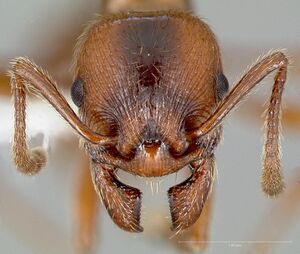Manica hunteri
| Manica hunteri | |
|---|---|

| |
| Scientific classification | |
| Kingdom: | Animalia |
| Phylum: | Arthropoda |
| Class: | Insecta |
| Order: | Hymenoptera |
| Family: | Formicidae |
| Subfamily: | Myrmicinae |
| Tribe: | Myrmicini |
| Genus: | Manica |
| Species: | M. hunteri |
| Binomial name | |
| Manica hunteri (Wheeler, W.M., 1914) | |
| Synonyms | |
| |
Typical habitat for this species is an opening in a coniferous forest. The elevation range is 2,300 feet (Alberta) to 9,000 feet at Angel Lake, Nevada.
Identification
Identification Keys including this Taxon
Key to Manica of North America
Distribution
Latitudinal Distribution Pattern
Latitudinal Range: 52.873° to 38.699672°.
| North Temperate |
North Subtropical |
Tropical | South Subtropical |
South Temperate |
- Source: AntMaps
Distribution based on Regional Taxon Lists
Nearctic Region: Canada, United States (type locality).
Distribution based on AntMaps
Distribution based on AntWeb specimens
Check data from AntWeb
Countries Occupied
| Number of countries occupied by this species based on AntWiki Regional Taxon Lists. In general, fewer countries occupied indicates a narrower range, while more countries indicates a more widespread species. |

|
Estimated Abundance
| Relative abundance based on number of AntMaps records per species (this species within the purple bar). Fewer records (to the left) indicates a less abundant/encountered species while more records (to the right) indicates more abundant/encountered species. |

|
Biology
Reproduction:
In British Columbia, nuptial flights occur from mid-August to mid-September. Colonies are presumably founded monogynously, and dealate queens are semi-claustral, (meaning they need to forage for food throughout the founding stages). Dealate queens often overwinter before beginning the egg laying process.
Foraging/Diet:
According to Miles Maxcer from Montana State University, this species' interest in food sources changes rapidly. Workers forage alone.
Castes
Worker
   
| |
| . | Owned by Museum of Comparative Zoology. |
Images from AntWeb
   
| |
| Worker. Specimen code casent0005698. Photographer April Nobile, uploaded by California Academy of Sciences. | Owned by UCDC, Davis, CA, USA. |
Nomenclature
The following information is derived from Barry Bolton's Online Catalogue of the Ants of the World.
- hunteri. Myrmica (Oreomyrma) hunteri Wheeler, W.M. 1914d: 121, fig. 1c (w.) U.S.A. (Montana).
- Type-material: 12 syntype workers.
- Type-locality: U.S.A.: Montana, Madison River, nr mouth of Beaver Creek, 7500 ft (S.J. Hunter).
- Type-depository: MCZC.
- Cole, 1957c: 212 (m.); Wheeler, G.C. & Wheeler, J. 1972b: 235 (l.).
- Combination in Myrmica (Neomyrma): Wheeler, W.M. 1917a: 507;
- combination in M. (Manica): Emery, 1921f: 43;
- combination in Manica: Weber, 1947: 440.
- Status as species: Wheeler, W.M. 1917a: 507; Emery, 1921f: 43; Essig, 1926: 862; Creighton, 1950a: 109; Smith, M.R. 1951a: 791; Cole, 1956h: 262; Cole, 1957c: 212; Smith, M.R. 1958c: 113; Smith, M.R. 1967: 351; Wheeler, G.C. & Wheeler, J. 1970a: 151 (redescription); Yensen, et al. 1977: 182; Wheeler, G.C. & Wheeler, J. 1978: 391; Smith, D.R. 1979: 1352; Allred, 1982: 486; Wheeler, G.C. & Wheeler, J. 1986g: 25; Bolton, 1995b: 249; Ward, 2005: 66.
- Senior synonym of aldrichi: Cole, 1956h: 262 (in text); Smith, M.R. 1958c: 113; Smith, D.R. 1979: 1352; Bolton, 1995b: 249.
- Distribution: Canada, U.S.A.
- aldrichi. Myrmica (Oreomyrma) aldrichi Wheeler, W.M. 1914d: 120, fig. 1b (w.) U.S.A. (Idaho).
- Type-material: 16 syntype workers.
- Type-locality: U.S.A.: Idaho, Moscow (J.M. Aldrich).
- Type-depository: MCZC.
- Combination in Myrmica (Neomyrma): Wheeler, W.M. 1917a: 507;
- combination in M. (Manica): Emery, 1921f: 42;
- combination in Manica: Weber, 1947: 440.
- Status as species: Wheeler, W.M. 1917a: 507; Emery, 1921f: 42; Essig, 1926: 862; Cole, 1936a: 36; Creighton, 1950a: 108; Smith, M.R. 1951a: 791.
- Junior synonym of hunteri: Cole, 1956h: 262 (in text); Smith, M.R. 1958c: 113; Smith, D.R. 1979: 1352; Bolton, 1995b: 249.
(Cole selected hunteri as the senior name for this species using the Principle of the First Reviser.)
Description
Worker: Length 4-6 mm.
Body and appendages brownish red or ferruginous, with a large, black, subtriangular spot on the vertex and a band of the same color across the posterior portion of the first gastric segment. Frontal area, posterior clypeal suture, antennal clubs and dental border of mandibles more or less infuscated. Upper surface of head with coarse, scattered punctures in addition to the rugae. Smooth areas on the head, thorax and pedicel. Hairs pale yellow. Anterior clypeal border entire. Base of propodeum somewhat flattened, anteroventral protuberance of postpetiole broadly rounded.
- Type
Described from a dozen specimens taken by Dr. S.J. Hunter from a couple of nests on the slopes of two mountains on the Madison River, nearly opposite the mouth of Beaver Creek, Montana, at an altitude of about 7,500 feet. The nests were in shaley earth and apparently of the crater type.
References
- Creighton, W. S. 1950a. The ants of North America. Bulletin of the Museum of Comparative Zoology 104: 1-585. (page 105, Manica revived status as genus) (page 109, Combination in Manica)
- Yensen, N. P.; Clark, W. H.; Francoeur, A. 1977. A checklist of Idaho ants (Hymenoptera: Formicidae). Pan-Pac. Entomol. 53: 181-187.
- Cole, A. C., Jr. 1956h. New synonymy in the genus Manica Jurine (Hymenoptera: Formicidae). J. Tenn. Acad. Sci. 31: 260-262. (page 262, senior synonym of aldrichi)
- Cole, A. C., Jr. 1957c. Descriptions of sexual castes of some ants in the genera Myrmica, Manica and Xiphomyrmex from the western United States (Hymenoptera: Formicidae). J. Tenn. Acad. Sci. 32: 208-213. (page 212, male described)
- Emery, C. 1921c. Hymenoptera. Fam. Formicidae. Subfam. Myrmicinae. [part]. Genera Insectorum 174A:1-94 94: 1-94 + 7 (page 43, Combination in M. (Manica))
- LaPolla, J.S. 2023. Fossil ants (Hymenoptera: Formicidae) of the early Oligocene Canyon Ferry Reservoir deposit. Palaeoentomology 6(4), 385-397 (doi:10.11646/palaeoentomology.6.4.10).
- Weber, N. A. 1947b. A revision of the North American ants of the genus Myrmica Latreille with a synopsis of the Palearctic species. I. Ann. Entomol. Soc. Am. 40: 437-474 (page 440, Combination in Manica)
- Wheeler, G. C.; Wheeler, J. 1970a. The natural history of Manica (Hymenoptera: Formicidae). Journal of the Kansas Entomological Society 43:129-162.
- Wheeler, G. C.; Wheeler, J. 1972b. Ant larvae of the subfamily Myrmicinae: second supplement on the tribes Myrmicini and Pheidolini. J. Ga. Entomol. Soc. 7: 233-246. (page 235, larva described)
- Wheeler, G. C.; Wheeler, J. 1988e. A checklist of the ants of Wyoming (Hymenoptera: Formicidae). Insecta Mundi 2:231-239.
- Wheeler, G.C. & J. Wheeler 1983. The superstructure of ant nests (Hymenoptera: Formicidae). Trans. American Entomological Society. 109:159-177.
- Wheeler, G.C.; Wheeler, J. 1978. Mountain ants of Nevada. Great Basin Naturalist 38: 379-396.
- Wheeler, W. M. 1914e. The American species of Myrmica allied to M. rubida Latreille. Psyche (Camb.) 21: 118-122. (page 121, fig. 1 worker described)
- Wheeler, W. M. 1917a. The mountain ants of western North America. Proc. Am. Acad. Arts Sci. 52: 457-569 (page 507, Combination in Myrmica (Neomyrmica))
- Zharkov, D., Dubovikoff, D., Abakumov, E. 2022. The first fossil record of the genus Manica Jurine, 1807 from Late Eocene Baltic amber and discussion of the early evolution of Myrmicini (Hymenoptera: Formicidae: Myrmicinae). Insects, 14, 21 (doi:10.3390/insects14010021).
References based on Global Ant Biodiversity Informatics
- Allred D. M. 1982. Ants of Utah. The Great Basin Naturalist 42: 415-511.
- Allred, D.M. 1982. The ants of Utah. Great Basin Naturalist 42:415-511.
- Borchert, H.F. and N.L. Anderson. 1973. The Ants of the Bearpaw Mountains of Montana (Hymenoptera: Formicidae). Journal of the Kansas Entomological Society 46(2):200-224
- Christiansen T., and R. Lavigne. 2010. Effects of the 1988 Fires in Yellowstone National Park, USA, on the Ant Populations (Hymenoptera: Formicidae). J. Entomol. Res. Soc. 12(3): 29-37.
- Cole A. C., Jr. 1957. Descriptions of sexual castes of some ants in the genera Myrmica, Manica and Xiphomyrmex from the western United States (Hymenoptera: Formicidae). Journal of the Tennessee Academy of Science 32: 208-213.
- Cole, A.C. 1936. An annotated list of the ants of Idaho (Hymenoptera; Formicidae). Canadian Entomologist 68(2):34-39
- Glasier, J. Alberta Ants. AntWeb.
- Hoey-Chamberlain R. V., L. D. Hansen, J. H. Klotz and C. McNeeley. 2010. A survey of the ants of Washington and Surrounding areas in Idaho and Oregon focusing on disturbed sites (Hymenoptera: Formicidae). Sociobiology. 56: 195-207
- Longino, J.T. 2010. Personal Communication. Longino Collection Database
- Michigan State University, The Albert J. Cook Arthropod Research Collection. Accessed on January 7th 2014 at http://www.arc.ent.msu.edu:8080/collection/index.jsp
- Parson G. L., G Cassis, A. R. Moldenke, J. D. Lattin, N. H. Anderson, J. C. Miller, P. Hammond, T. Schowalter. 1991. Invertebrates of the H.J. Andrews Experimental Forest, western Cascade Range, Oregon. V: An annotated list of insects and other arthropods. Gen. Tech. Rep. PNW-GTR-290. Portland, OR: U.S. Department of Agriculture, Forest Service, Pacific Northwest Research Station. 168 p.
- Sharplin, J. 1966. An annotated list of the Formicidae (Hymenoptera) of Central and Southern Alberta. Quaetiones Entomoligcae 2:243-253
- Wheeler G. C., and J. Wheeler. 1986. The ants of Nevada. Los Angeles: Natural History Museum of Los Angeles County, vii + 138 pp.
- Wheeler J. N., G. C. Wheeler, R. J. Lavigne, T. A. Christiansen, and D. E. Wheeler. 2014. The ants of Yellowstone National Park. Lexington, Ky. : CreateSpace Independent Publishing Platform, 2013. 112 pages.
- Wheeler, G.C. and J. Wheeler. 1970. The natural history of Manica (Hymenoptera: Formicidae). Journal of Kansas Entomological Society 43(2):129-162
- Wheeler, G.C. and J. Wheeler. 1978. Mountain ants of Nevada. Great Basin Naturalist 35(4):379-396
- Wheeler, G.C. and J. Wheeler. 1988. A checklist of the ants of Montana. Psyche 95:101-114
- Wheeler, G.C. and J. Wheeler. 1988. A checklist of the ants of Wyoming. Insecta Mundi 2(3&4):230-239

